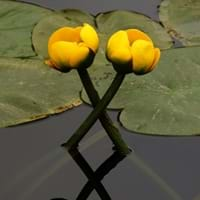Life Span
Perennial
Perennial
Origin
Eastern Asia
North America
Types
Actinidia arguta, Actinidia giraldii, Actinidia hypoleuca
not available
Number of Varieties
Not Available
Habitat
Dappled Shade, open Woodlands
canals, Lakes, marshes, Ponds, sloughs, sluggish streams and rivers, springs
USDA Hardiness Zone
3-8
3-12
Sunset Zone
1a, 1b, 2a, 2b, 3a, 3b, 4, 5, 6, 7, 8, 9, 14, 15, 16, 17, 18, 19, 20
21,22
Habit
Vining/Climbing
Clump-Forming
Minimum Width
Not Available
Flower Color
White, Ivory
Yellow
Flower Color Modifier
Bicolor
Not Available
Fruit Color
Green, Yellow green
Non Fruiting Plant
Leaf Color in Spring
Green, Dark Green
Green, Dark Green
Leaf Color in Summer
Dark Green
Green, Dark Green
Leaf Color in Fall
Dark Green
Green, Dark Green
Leaf Color in Winter
Light Green
Not Available
Leaf Shape
Oval
Heart-shaped
Plant Season
Spring, Summer, Fall
Spring, Summer, Fall
Sunlight
Full Sun, Partial Sun
Full Sun, Partial Sun
Type of Soil
Loam
Clay, Loam, Sand
The pH of Soil
Neutral
Acidic, Neutral, Alkaline
Soil Drainage
Well drained
Poorly Drained
Bloom Time
Spring, Late Spring, Early Summer
Summer, Late Summer
Tolerances
Shade areas
Wet Site
Where to Plant?
Ground, Pot
In Water
How to Plant?
Grafting, Stem Cutting
Seedlings
Plant Maintenance
Low
Medium
Watering Requirements
Average Water Needs, Requires regular watering
Plant grows in water
In Summer
Regular watering required
Aquatic Plant
In Spring
Moderate
Aquatic Plant
In Winter
Average Water
Aquatic Plant
Soil pH
Neutral
Acidic, Neutral, Alkaline
Soil Type
Loam
Clay, Loam, Sand
Soil Drainage Capacity
Well drained
Poorly Drained
Sun Exposure
Full Sun, Partial Sun
Full Sun, Partial Sun
Pruning
Remove damaged leaves, Remove dead branches, Remove dead leaves
No pruning needed
Fertilizers
Apply 10-10-10 amount, fertilize twice a year
Not Available
Pests and Diseases
Botrytis head rot, Japanese Beetles, Leaf Rollers, Nematodes, Phytophthora, Root rot, Sclerotinia blight, Spider mites, Thripes
Aphids, Beetles, China Mark Moth, Leaf Rollers, Leeches, Lily Leaf Spot, Mosquito, Muck Midge, Ostracods, Snails, Spider mites, Tadpoles, Whiteflies
Plant Tolerance
Shade areas
Wet Site
Flower Petal Number
Single
Single
Foliage Texture
Medium
Coarse
Foliage Sheen
Glossy
Glossy
Attracts
Cats
Not Available
Allergy
Not Available
Not Available
Aesthetic Uses
Cottage Garden
Showy Purposes
Beauty Benefits
Not Available
Not Available
Environmental Uses
Shadow Tree
Ethnobotanic, Wildlife
Medicinal Uses
Antioxidants, Fiber, Folate, Rich in Potassium, Vitamin C
Anaphrodisiac, Anodyne, Antiscrophulatic, Antispasmodic, Astringent, Cardiotonic, Demulcent, Hypotensive, Sedative, Vasoconstrictor
Part of Plant Used
Fruits
Flowers, Root
Other Uses
Grown for shade
Used As Food, Used as Ornamental plant
Used As Indoor Plant
No
No
Used As Outdoor Plant
Yes
Yes
Garden Design
Edible, Feature Plant, Vine
Water Gardens
Botanical Name
ACTINIDIA arguta
NUPHAR lutea
Common Name
Hardy Kiwi
Common Spatterdock, Yellow Pond Lily
In Hindi
हार्डी कीवी
पीला तालाब लिली
In German
Hardy Kiwi
Gelbe Teichrose
In French
kiwai
Jaune nénuphar
In Spanish
kiwi hardy
Lirio amarillo estanque
In Greek
σκληραγωγημένα ακτινίδια
Κίτρινο λίμνη κρίνος
In Portuguese
kiwi Hardy
Lagoa do lírio amarelo
In Polish
hardy kiwi
Żółty staw lilii
In Latin
Hardy kiwi
Yellow piscinam lilium
Phylum
Magnoliophyta
Magnoliophyta
Class
Magnoliopsida
Liliopsida
Order
Theales
Nymphaeales
Family
Actinidiaceae
Nymphaeaceae
Clade
Angiosperms, Asterids, Eudicots
Angiosperms
Tribe
Not Available
Not Available
Subfamily
Actinidiaceae
Not Available
Number of Species
Not Available
Not Available
Importance of Hardy Kiwi and Yellow Pond Lily
Want to have the most appropriate plant for your garden? You might want to know the importance of Hardy Kiwi and Yellow Pond Lily. Basically, these two plants vary in many aspects. Compare Hardy Kiwi and Yellow Pond Lily as they differ in many characteristics such as their life, care, benefits, facts, etc. Every gardener must at least have the slightest clue about the plants he wants to plant in his garden. Compare their benefits, which differ in many ways like facts and uses. The medicinal use of Hardy Kiwi is Antioxidants, Fiber, Folate, Rich in Potassium and Vitamin C whereas of Yellow Pond Lily is Anaphrodisiac, Anodyne, Antiscrophulatic, Antispasmodic, Astringent, Cardiotonic, Demulcent, Hypotensive, Sedative and Vasoconstrictor. Hardy Kiwi has beauty benefits as follows: Not Available while Yellow Pond Lily has beauty benefits as follows: Not Available.
Compare Facts of Hardy Kiwi vs Yellow Pond Lily
How to choose the best garden plant for your garden depending upon its facts? Here garden plant comparison will help you to solve this query. Compare the facts of Hardy Kiwi vs Yellow Pond Lily and know which one to choose. As garden plants have benefits and other uses, allergy is also a major drawback of plants for some people. Allergic reactions of Hardy Kiwi are Not Available whereas of Yellow Pond Lily have Not Available respectively. Having a fruit bearing plant in your garden can be a plus point of your garden. Hardy Kiwi has no showy fruits and Yellow Pond Lily has no showy fruits. Also Hardy Kiwi is not flowering and Yellow Pond Lily is not flowering . You can compare Hardy Kiwi and Yellow Pond Lily facts and facts of other plants too.





